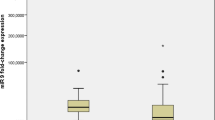Abstract
Transitional cell carcinoma (TCC) of the bladder is a solid tumor that induces angiogenesis to maintain nutrition and oxygenation of tumor cells. Maspin, a serpin with tumor suppressing activity, has recently been identified as an inhibitor of angiogenesis. This study examined the impact of maspin expression in the growth pattern of TCC of the bladder. Maspin was identified in a panel of normal tissues, in several bladder carcinoma cell lines, and 51 patient samples of TCC of the bladder. Expression was detected by RT-PCR and immunohistochemistry. Furthermore, the level of maspin was correlated to the growth rate of bladder tumor cell lines in vitro and in vivo. Maspin expression was found in high quantities in normal urothelium. Maspin expression was preserved in superficial bladder cancers but was significantly diminished in invasive carcinomas. Within the group of invasive TCCs, maspin expression was inversely correlated to the patient prognosis. Furthermore, low maspin expression level was coupled to an increased tumor cell growth in vivo. Down-regulation of maspin expression seems to be a specific event in the progression of invasive bladder carcinoma. Maspin might be a useful marker to determine the prognosis of invasive TCC. Furthermore, maspin re-expression might become a therapeutic option in the treatment of invasive, metastatic TCC.




Similar content being viewed by others
References
Zou Z, Anisowicz A, Hendrix MJ, Thor A, Neveu M, Sheng S, Rafidi K, Seftor E, Sager R (1994) Maspin, a serpin with tumor-suppressing activity in human mammary epithelial cells. Science 263:526–529
Zhang M, Volpert O, Shi YH, Bouck N (2000) Maspin is an angiogenesis inhibitor. Nat Med 6:196–199
Lin C-W, Lin JC, Prout GR Jr (1985) Establishment and characterization of four human bladder tumor cell lines and sublines with different degrees of malignancy. Cancer Res 45:5070–5079
Rigby CC, Franks LM (1970) A human tissue culture cell line from a transitional cell tumor of the urinary bladder: growth, chromosome pattern and ultrastructure. Br J Cancer 24:746–754
Moll R, Achtstatter T, Becht E, Balcarova-Stander J, Ittensohn M, Franke WW (1988) Cytokeratins in normal and malignant transitional epithelium. Maintenance of expression of urothelial differentiation features in transitional cell carcinomas and bladder carcinoma cell culture lines. Am J Pathol 132:123–144
Jackson AM, Alexandrov AB, Prescott S, James K, Chisholm GC (1992) Expression of adhesion molecules by bladder cancer cells: modulation by interferon-gamma and tumour necrosis factor-alpha. J Urol 148:1583–1586
Hanahan D, Folkman J (1996) Patterns and emerging mechanisms of the angiogenic switch during tumorigenesis. Cell 86:353–364
Boehm T, Folkman J, Browder T, O’Reilly M (1997) Antiangiogenic therapy of experimental cancer does not induce acquired drug resistance. Nature 390:404–407
Sugimoto S, Maass N, Takimoto Y, Sato K, Minei S, Zhang M, Hoshihawa Y, Junemann KP, Jonat W, Nagasaki K (2004) Expression and regulation of tumor suppressor gene maspin in human bladder cancer. Cancer Lett 203:209–215
Wang MC, Yang YM, Li XH, Dong F, Li Y (2004) Maspin expression and its clinicopathological significance in tumorigenesis and progression of gastric cancer. World J Gastroenterol 10:634–637
Cher ML, Biliran HR Jr, Bhagat S, Meng Y, Che M, Lockett J, Abrams J, Fridmann R, Zachareas M, Sheng S (2003) Maspin expression inhibits osteolysis, tumor growth, and angiogenesis in a model of prostate cancer bone metastasis. Proc Natl Acad Sci USA 100:7847–7852
Lim YJ, Lee JK, Jang WY, Song SY, Lee KT, Paik SW, Rhee JC (2004) Prognostic significance of maspin in pancreatic ductal adenocarcinoma. Korean J Intern Med 19:15–18
Ito Y, Yoshida H, Tomoda C, Uruno T, Takamura Y, Miya A, Kobayashi K, Matsuzuka F, Matsuura N, Kuma K, Miyauchi A (2004) Maspin expression is directly associated with biological aggressiveness of thyroid carcinoma. Thyroid 14:13–18
Yatabe Y, Mitsudomi T, Takahashi T (2004) Maspin expression in normal lung and non-small-cell lung cancers: cellular property-associated expression under the control of promoter DNA methylation. Oncogene 23:4041–4049
Friedrich MG, Toma Mi, Petri S, Cheng JC, Hammerer P, Erbersdobler A, Huland H (2004) Expression of maspin in non-muscle invasive bladder carcinoma: correlation with tumor angiogenesis and prognosis. Eur Urol 45:737–743
Author information
Authors and Affiliations
Corresponding author
Additional information
This study was supported in part by Medac GmbH.
Rights and permissions
About this article
Cite this article
Beecken, WD., Engl, T., Engels, K. et al. Clinical relevance of maspin expression in bladder cancer. World J Urol 24, 338–344 (2006). https://doi.org/10.1007/s00345-006-0085-z
Received:
Accepted:
Published:
Issue Date:
DOI: https://doi.org/10.1007/s00345-006-0085-z




